Abstract
Nowadays, the combination of new technologies and the use of mobile devices opens up a new range of teaching–learning strategies in different agricultural engineering degrees. This article presents an augmented reality tool that allows for improved spatial viewing for students who have certain difficulties with viewing graphic representations of agronomic systems and devices. This tool is known as ARTID (Augmented Reality for Teaching, Innovation and Design) and consists in a free-access mobile application for devices using the Android operating system. The proposed method provides each exploded drawing or overall drawing with a QR code that can be used by students to view their 3D models by augmented reality in their own mobile devices. An evaluation experience was carried out to assess the validity of the tool on different devices and the acceptance and satisfaction level of this kind of resources in subjects of graphic expression in engineering. Finally, an example of application in the agronomic domain is provided by the 3D virtual model of portable ferticontrol equipment that comprises the different structures and tanks, which, if viewed by conventional graphical representations, may entail a certain level of difficulty. Thanks to this tool, reality can be merged with the virtual world to help favour the understanding of certain concepts and to increase student motivation in agronomy studies.
1. Introduction
Nowadays, augmented reality (AR) is being introduced into many areas of society, especially since advertising has mostly driven its development given the effects that it has on potential customers [1,2,3]. Indeed, more and more AR applications are being used, especially as smartphones and Internet access have boomed because, thanks to location, users can be shown data about their position [4], seek new experiences and sensations [5] or encourage different types of family activities [6].
In the teaching area, this technology is becoming particularly relevant and is applied to different levels of education and subjects [7,8,9,10,11]. Viewing 3D objects in space is one of the main challenges that engineering students face during their academic training. Rapid technological development, along with growing popularity and easy access to smart mobile devices, has enabled the development of new opportunities to improve teaching quality [12,13], which, in turn, leads to more motivation and higher learning levels for the students who resort to them [14]. It has been demonstrated that using such technologies inside and outside classrooms can increase the understanding and motivation of the students registered for technical drawing subjects in engineering degrees [15]. Specifically, a study that uses virtual reality in engineering students to assess spatial capacity can be found in literature, showing that the use of this type of technology significantly improves these capacities in the students who use them. The only drawback of this technology is the need for special devices, such as virtual reality glasses with a smartphone [16].
In the literature, we can find various resources where AR focused on education is used with very interesting results, such as a mathematics textbook for secondary education, which could be validated and considered as an appropriate tool for the teaching–learning process [17]. In other fields, the younger generation tends to see history as an uninteresting and boring subject, and, for this reason, the development of books with AR can favour interest and the acquisition of knowledge in a more satisfactory way [18,19]. Libraries have also investigated the use of web-based AR by means of ISBN barcodes on the books themselves [20] or generating the editorial design of an educational book about environmental issues, including AR for children from 6 to 8 years [21]. This type of technology has also been incorporated into language learning, where the experimental results revealed that AR-based learning activities can better help students in understanding and expressing themselves about learning contents instead of passively listening to the teacher or reading books [22]. In subjects related to graphic expression in engineering, several didactic materials that use AR with results that demonstrate a positive impact on students’ ability in their spatial skills can be found [23].
The advantage of AR is that it allows students to zoom in/out and rotate 3D models, and to perceive contents in a more appealing manner, which encourage them to learn. Configuration and viewing are not easy processes because different elements need to be taken into account. Of all the analysed resources, it is worth mentioning those that use AR by scanning QR codes with smartphones [24]. This is the case of a colouring book application that was developed for an aquarium musem. The mobile application, along with the Android operating system and AR, allowed users to express, create and interact with their creativity through colouring activities [25].
In the graphic expression domain, the spatial viewing skill needs to be trained in with most cases. Former studies have verified that using different technologies, including AR, can favour this skill in STEM (Science, Technology, Engineering and Mathematics) studies [26,27,28,29,30].
For this reason, this paper describes the creation of a mobile application to visualize, using AR and QR codes, 3D virtual models of figures used in graphic expression subjects. A test was carried out in the following subjects taught at the Technical University of Cartagena during the course 2018–19:
- ▪
- Graphic Expression: Degree in Mechanical Engineering, Degree in Electrical Engineering, Degree in Automation and Industrial Electronic Engineering, Degree in Chemical and Industrial Engineering and Degree in Industrial Technologies Engineering.
- ▪
- Industrial Design: Degree in Mechanical Engineering.
This test validated the suitability of using the application in different devices, as well as the level of student satisfaction after using the tool. In order to help gain an understanding of graphic representations with exploded drawings and overall drawings in agricultural engineering degrees, the mobile application ARTID (Augmented Reality for Teaching, Innovation and Design) was developed for viewing virtual 3D models by AR. The objective was to use such tools inside and outside classrooms to favour students’ understanding and motivation in different university degree subjects.
2. ARTID Tool
The main objectives to create and develop the AR ARTID tool for its application in graphic expression subjects in the agronomic domain were to:
- ▪
- Develop a support tool for those teachers teaching the subject inside and outside classrooms;
- ▪
- Turn classes into more interactive and dynamic activities to motivate students;
- ▪
- Help students to develop their spatial viewing and to, thus, understand the exercises given in class;
- ▪
- Create and make available an open access tool for all those students interested in the topic.
To develop the ARTID application, we resorted to using different software, which allowed us to obtain an easy-to-use and open access tool. Its development process can be divided into three main phases (see Figure 1): (i) creating QR stamps to scan and reproduce parts; (ii) 3D modelling of parts; (iii) joining stamps and parts in the Unity programme.
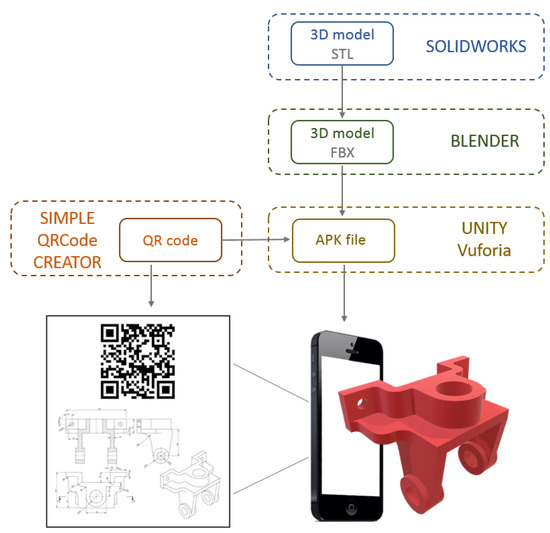
Figure 1.
Scheme of the proposed methodology.
2.1. Stamp Creation
The stamp corresponds to the image that must be scanned via the mobile phone to project a part in AR. To create it, the following indications need to be considered:
- (a)
- The stamp must be unique. It is important to avoid the 3D model taking a long time to appear or another object appearing in its place. So, an abstract, but well-defined, image must be selected. Using QR images in ARTID was chosen because it makes two equal images look somewhat difficult.
- (b)
- Stamp size must be optimum to project the model. If the stamp is small, it can be projected more quickly, but lacks details. If it is very big, the part might not be generated or take too long to appear (Figure 2). The defined optimum size for this tool would be a stamp whose approximate dimensions would be 11 × 11 cm so it fits in an A4 format.
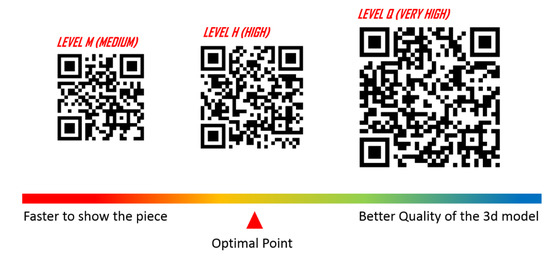 Figure 2. Different levels and qualities.
Figure 2. Different levels and qualities.
Different options are available to create the QR code as both websites and applications can be used. For this tool, the Simple QRCode Creator application was employed, which is free and easy to use, and is obtained from the Microsoft Store. To use it, the only thing that users had to do was to introduce a text (the more characters in the QR definition name, the more unique it will be) and the encryption level, which was set at high (selection of the ECC (Error Correction Feature) level, the higher the level, the lower the probability of reading failure).
2.2. 3D Modelling Parts
The second stage involves the 3D modelling of parts. To do so, we resorted to the design and 3D modelling SolidWorks 2018 programme (Dassault Systèmes). In order to import the 3D parts in Unity (Unity Technologies, a licensed software that can be used for educational and not-for-profit purposes), they must take the FBX (FilmBoX) format, and the steps below are followed:
- (a)
- Export the 3D models obtained in Solidworks to the STL (STereoLithography) format. The STL format transforms the piece into a single 3D model made up of triangles; the greater the number of triangles, the more definition the 3D model will have, but, in turn, it will be more difficult to project it onto the stamp (Figure 3).
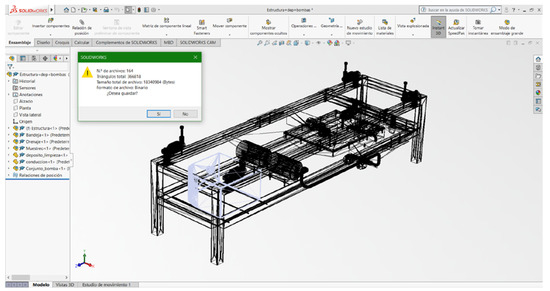 Figure 3. Screenshot of the SolidWorks software.
Figure 3. Screenshot of the SolidWorks software. - (b)
- Import the STL file in the Blender software (Fundación Blender, free multiplatform software) to add colour or textures. Blender allows you to apply textures and colors on the piece as well as allowing you to go from STL format to FBX (Figure 4).
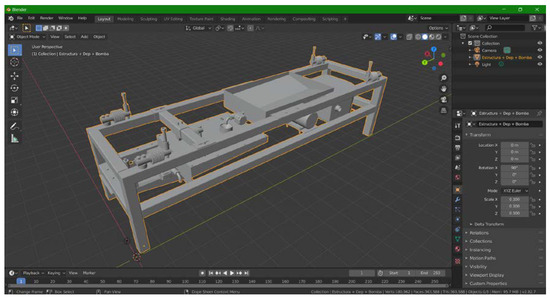 Figure 4. Screenshot of the Blender software.
Figure 4. Screenshot of the Blender software. - (c)
- Export the STL file in Blender to the FBX format. If models are directly drawn in Blender, they do not need the first conversion.
2.3. Creating the Augmented Reality Tool
Vuforia is a software development kit (SDK) that allows work to be done with AR. Both Vuforia and Unity are licensed software that can be used for education and not-for-profit purposes, whose authorisation was requested to do this work. This stage involves two work phases:
- (a)
- Firstly, the stamps created in the previous stage must be uploaded. To do so, the Vuforia website (https://developer.vuforia.com) is employed. A file is created that has to be added to Unity (Figure 5).
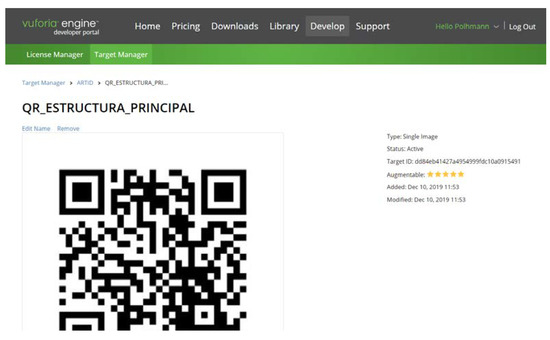 Figure 5. Screenshot of the Vuforia software.
Figure 5. Screenshot of the Vuforia software. - (b)
- Secondly, the work area in the Vuforia tool is found in the GameObjects tab in Unity. The file generated in Vuforia must be executed when Unity is open, and the chosen stamps must be added. Vuforia is accessed by the GameObjects tab and ARCamera is selected. Stamps are added in ARCamera (ImageTarget), followed by the 3D models (Figure 6).
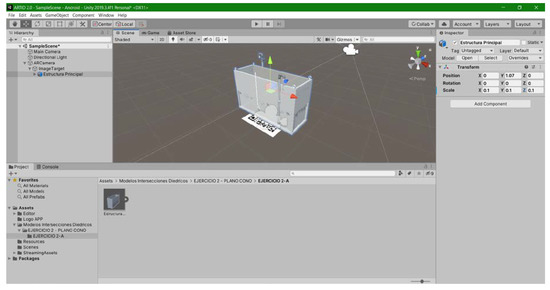 Figure 6. Screenshot of the Unity software.
Figure 6. Screenshot of the Unity software. - (c)
- Once the 3D models and QR codes are associated, the model must be customized in terms of size, brightness, shadows and position on the QR. In case any model has a texture or image applied to its surface, it must be implemented in Unity creating a “Material” and applying it to the model surface.
In Unity, it is necessary to follow a series of configuration procedures to generate the application:
- -
- Select the Android version required for the application to run. In this study, only versions greater than 4.0 were chosen.
- -
- Choose the cameras used on the device (front/rear). In this study, we opt for the rear camera because it is usually the camera with the best quality.
- -
- Configure whether the application can be used vertically or horizontally (Portrait or Landscape).
- -
- Define the amount of graphics memory used on the device. The more memory it has, the faster the model will be displayed.
- -
- And other minor settings, s application logo, encryption keys to protect the application or author assignment, among others.
After following all these steps, the Build button is clicked on to create the “.apk” file of the final application to be installed in the mobile device.
Currently, 3D models are embedded within the .apk file. In future studies, the application will be developed to download via streaming the required 3D models when the camera focuses on a QR code.
In addition, a website (www.artid.es) where you can find information related to augmented reality and download this application has been developed. The application is currently passing the Google approval process to be introduced within the Google Play Store, enabling an easier way of downloading it onto mobile devices.
3. Experience with Students
3.1. Participants
In order to verify the suitability of the created application, a test was performed to the students of the following subjects taught at the Technical University of Cartagena during the course 2018–19 (Table 1):

Table 1.
Participants by subjects and degrees.
- -
- Graphic Expression (Degree in Mechanical Engineering, Degree in Electrical Engineering, Degree in Automation and Industrial Electronic Engineering, Degree in Chemical and Industrial Engineering and Degree in Industrial Technologies Engineering).
- -
- Industrial Design (Degree in Mechanical Engineering).
3.2. Procedure
The test was carried out by teachers in the area of graphic expression in engineering, conducting a pilot experience in each of the subjects indicated above. The main objectives of this pilot test were the following:
- (a)
- Collect technical information on the use of the ARTID application on different mobile devices with the Android operating system. With this type of information, the aim was to determine: (i) the accessibility and management of the application, (ii) the feasibility of using geometric 3D models and QR codes, and (iii) the effectiveness of the application, analyzing possible failures and errors.
- (b)
- Collect teaching information about the ARTID tool in drawing subjects. This type of information is more subjective and sought to determine: (i) the acceptance of this type of technology by students in graphic expression and industrial design subjects, (ii) the perception of usefulness that students could have with this type of tool, and (iii) the level of satisfaction of these less conventional activities focused on teaching.
During the test, which lasted 20 min, teachers interacted with students to answer questions and exchange opinions. Participation in the test was totally voluntary and consisted of three phases:
- i
- A presentation of the tool, where students were given with the instructions for the download and installation of the application on their mobile devices through the web www.artid.es.
- ii
- The completion of a practical test where a set of four planes with QR codes was provided to each student in order to probe the tool (Figure 7 and Figure 8).
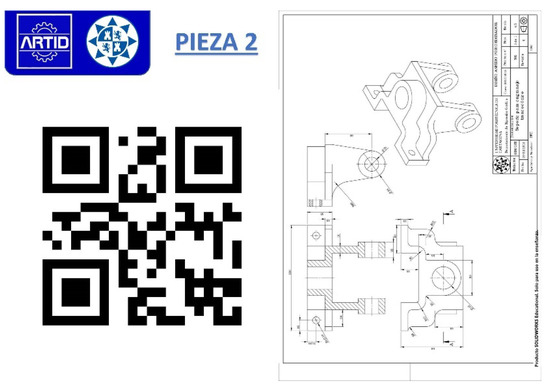 Figure 7. One of the plans with a QR code used in the test.
Figure 7. One of the plans with a QR code used in the test.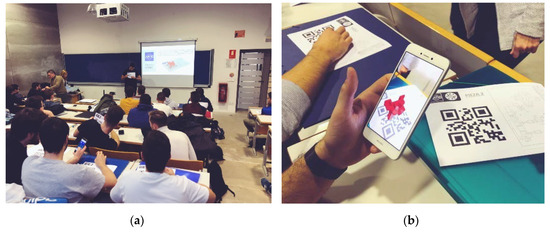 Figure 8. (a) Photograph of the class where the test was performed, (b) one student capturing the QR code during the test.
Figure 8. (a) Photograph of the class where the test was performed, (b) one student capturing the QR code during the test. - iii
- After completing the use test, the students accessed through the web and made an anonymous and voluntary online survey to assess technical aspects of the tool and collect their opinion about the use of augmented reality applications in the graphic expression and industrial design subjects. The questions raised were open in order to collect preliminary information and data on this tool that could serve to continue advancing in this research line.
3.3. Results
The activity was carried out by a total of 188 students whose mobile device was endowed with Android Operating System v4.2 or higher. The results obtained in the survey (see Table 2) show: (i) a proper operation of the application in the majority of the mobile devices used, (ii) agility in the visualization of the 3D models, and (iii) an adequate interaction of the students with the application. On the other hand, the combination of AR together with the handling of mobile devices is very attractive to students, so they perceive a great utility of the tool in the teaching field. During this activity, many of the students who participated showed their interest and asked for and extended version with more exercises. The collection of this preliminary information favours the development of materials and specific exercises with AR in the different subjects of graphic expression in engineering. Once these materials have been produced, a more objective and analytical study can be performed to determine the cognitive and practical advantages of this tool when used by students in relation to their spatial vision and learning.

Table 2.
Results of the survey conducted by the students.
4. ARTID Tool in the Agronomic Domain
In addition to the test performed to the students, another example of using this technology in agronomic studies was developed. In this case, a ferticontrol equipment, based on the weighing lysimeter developed in the Agromatic and Sea Engineering Research Group of the Universidad Politécnica de Cartagena (Figure 9), was employed as a 3D model. This device is formed by several structures and is located on a farm. The crop container, which holds a volume of reconstituted soil taken from the plot, reproduces natural conditions to determine crop evapotranspiration while it grows, as well as water/nutrient uses and losses through leaching. Apart from acting as an infiltrometer and pluviometer, it determines waterlogging and/or surface runoff. This allows optimum fertirrigation management with no losses through surface runoff or drainage.
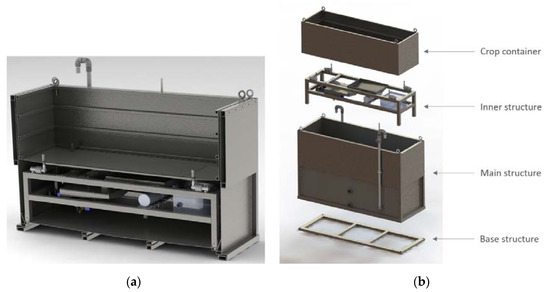
Figure 9.
Three-dimensional model of the ferticontrol equipment based on weighing lysimeter: (a) cross-sectional view of the equipment; (b) exploded view of the equipment with its main structures.
The 3D models of the proposed ferticontrol equipment and the QR codes were developed following the procedure described in the previous chapter (Figure 10). Next, a series of overall drawings and exploded drawings was produced with 2D and 3D views, to which the corresponding QR codes were added to view them. In this case, the ferticontrol equipment was formed by different structures, which were represented on several drawings, similarly to those offered in Figure 11. The QR code that comes with each drawing can be scanned when students require further graphical information or wish to view the structure from a new perspective, which encourages students’ interest and understanding.
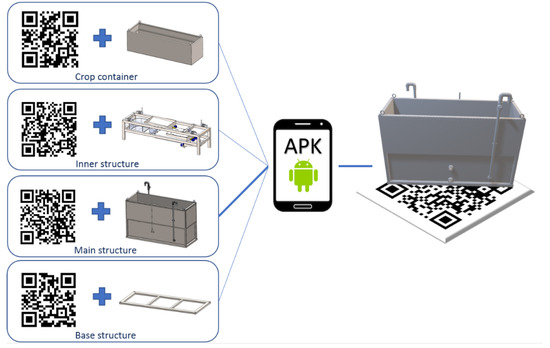
Figure 10.
Procedure with proposed ferticontrol equipment.
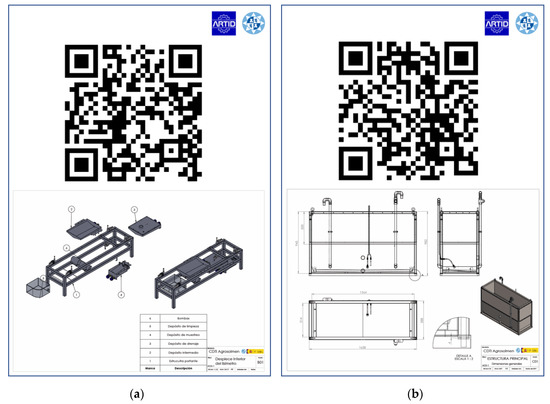
Figure 11.
Example of the ferticontrol equipment drawings with QR codes: (a) inner structure; (b) main structure.
Using these codes consists in focusing them by means of the ARTID application in a mobile device where the related 3D model is automatically shown (Figure 12). The position of the mobile device and its angle in relation to the drawing can be changed to view 3D models from several perspectives, but by always focusing these codes.
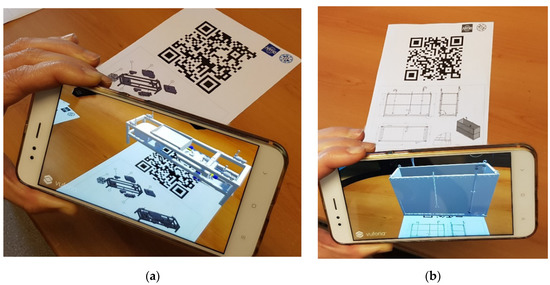
Figure 12.
Viewing two ferticontrol equipment structures with the Augmented Reality for Teaching, Innovation and Design (ARTID) application: (a) inner structure; (b) main structure.
5. Discussion
Nowadays, augmented reality is a widely used tool in certain technological sectors. On the one hand, it is used in the field of entertainment, such as video games, trying to provide the user with a more interactive experience. On the other hand, it is applied in various industrial sectors to show designs and projects in a more graphical way. All this gives the tool great potential to be developed, so the companies that develop software for programming AR-based applications ask for a fee for its use. When creating an augmented reality application for non-profit purposes, it is difficult to find free software tools.
One of the main problems found in this study was the devices that are normally used for augmented reality, in this case, mobile phones. Projecting 3D elements with great definition on a screen is much easier using a computer that has more processing capacity compared to a mobile phone or tablet. It is a problem that, over time, is solved thanks to the fact that mobile devices have increasingly better characteristics; even so, it is still a barrier. On the other hand, developing an application is not complicated thanks to the wide variety of tutorials and programming courses on Android, but tutorials for something as specific as augmented reality are scarce. The ARTID application stands out for being direct and easy to use, so no menus or interfaces have been included, which also improves its performance and functionality.
The ARTID tool can be extrapolated to any teaching field, technological or not, or to other fields, such as archaeology, medicine or agronomy. In addition, it allows the use of 3D models created in any design software, not only the one proposed in this study.
According to the experience carried out with the industrial engineering students, this interactive way of learning produces greater motivation, since they use tools that are very attractive to them. This can allow students to better assimilate content and visualize more complex graphical representations more effectively. This hypothesis, that has already been validated in some studies referenced in this article, will be a future research line with the aim of validating the ARTID tool.
6. Conclusions
This study describes the process of creating a tool based on augmented reality and called ARTID. The main objective of this new tool is to obtain an open source application that allows to visualize, through augmented reality and QR codes, different types of pieces and sets usually used in technical drawing subjects. To verify the proper functioning of the application, a test was carried out by 188 students of the graphic expression and industrial design subjects taught in several degrees at the Technical University of Cartagena. The obtained results were very satisfactory, since the application ran properly in practically all the mobile devices with the Android operating system. The survey results reveal that students find the tool very interesting, useful and with a great scope that enhances to continue working on a more definitive version. To demonstrate its usefulness in the agronomic domain, it was also employed to view the construction detail of a ferticontrol equipment based on weighing lysimeter. The 3D viewing of objects in space is a challenge for engineering students and these technologies can help to acquire this skill. Developing such applications opens up a wide range of possibilities in teaching as they allow students to interact with the graphic representations that complete degree subject contents.
Author Contributions
Conceptualization, D.P.-B. and D.G.F.-P.; methodology, D.P.-B., D.G.F.-P. and T.P.B.; software, T.P.B.; validation, D.P.-B. and D.G.F.-P.; investigation, D.P.-B. and T.P.B.; resources, M.S.-M. and J.M.M.-M.; writing—original draft preparation, D.P.-B.; writing—review and editing, D.G.F.-P. and J.M.M.-M; visualization, T.P.B.; supervision, M.S.-M. and J.M.M.-M. All authors have read and agreed to the published version of the manuscript.
Funding
This work has been carried out in the framework of the Research and Development Project with reference IDI-20190146 and entitled “Development and implantation of a ferticontrol equipment for weighing lysimeter for use in intensive agriculture”, in collaboration with the company AGROSOLMEN SL, and co-financed by the European Regional Development Fund (FEDER) through the 2014–2020 Multiregional Operational Program of Spain.
Conflicts of Interest
The authors declare no conflict of interest.
References
- Azuma, R.T. A survey of augmented reality. Presence Teleoperators Virtual Environ. 1997, 6, 355–385. [Google Scholar] [CrossRef]
- Fan, X.; Chai, Z.; Deng, N.; Dong, X. Adoption of augmented reality in online retailing and consumers’ product attitude: A cognitive perspective. J. Retail. Consum. Serv. 2020, 53. [Google Scholar] [CrossRef]
- Yang, S.; Carlson, J.R.; Chen, S. How augmented reality affects advertising effectiveness: The mediating effects of curiosity and attention toward the ad. J. Retail. Consum. Serv. 2020, 54. [Google Scholar] [CrossRef]
- Uribe, F.C. Realidad aumentada aplicada a la enseñanza de la geometría descriptiva. AUS 2017, 18–22. [Google Scholar]
- Park, S.; Stangl, B. Augmented reality experiences and sensation seeking. Tour. Manag. 2020, 77. [Google Scholar] [CrossRef]
- Shin, H.; Gweon, G. Supporting preschoolers’ transitions from screen time to screen-free time using augmented reality and encouraging offline leisure activity. Comput. Hum. Behav. 2020, 105. [Google Scholar] [CrossRef]
- Arora, R.; Kazi, R.H.; Grossman, T.; Fitzmaurice, G.; Singh, K. SymbiosisSketch: Combining 2D & 3D sketching for designing detailed 3D objects in situ. In Proceedings of the Conference on Human Factors in Computing Systems—Proceedings, Montreal, QC, Canada, 21–26 April 2018. [Google Scholar]
- Atrio Cerezo, S.; Guardado Moreno, E. La realidad aumentada y su presencia en un modelo docente tecnológico para la didáctica de la Química en Bachillerato. Educación y Tecnología 2012, 1, 9–38. [Google Scholar]
- Chang, H.Y.; Hsu, Y.S.; Wu, H.K.; Tsai, C.C. Students’ development of socio-scientific reasoning in a mobile augmented reality learning environment. Int. J. Sci. Educ. 2018, 1–22. [Google Scholar] [CrossRef]
- Ibáñez, M.B.; Delgado-Kloos, C. Augmented reality for STEM learning: A systematic review. Comput. Educ. 2018, 123, 109–123. [Google Scholar] [CrossRef]
- Suh, A.; Prophet, J. The state of immersive technology research: A literature analysis. Comput. Hum. Behav. 2018, 86, 77–90. [Google Scholar] [CrossRef]
- Ferrer Torregrosa, J.; Jiménez Rodríguez, M.Á.; Barcia González, J.M.; Torralba Estellés, J. La realidad aumentada en la docencia de ciencias de la salud. Nuevos Caminos para la Comprensión 2014. [Google Scholar]
- Lineros, M.L.; Jiménez, F.J.S.; Carballo, F.M.; Tatay, C.V. Realidad Aumentada Como Herramienta Docente en la Asignatura de Construcción en las Enseñanzas de Ingeniería. Proceedings of 24 Congreso de Innovación Educativa en las Enseñanzas Técnicas, Cádiz, Spain, 21–23 September 2016; Universidad de Cádiz: Cádiz, Spain; p. 10. [Google Scholar]
- Redondo, B.; Cózar-Gutiérrez, R.; González-Calero, J.A.; Sánchez Ruiz, R. Integration of Augmented Reality in the Teaching of English as a Foreign Language in Early Childhood Education. Early Child. Educ. J. 2020, 48, 147–155. [Google Scholar] [CrossRef]
- Juan, C.; YuLin, W.; Tjondronegoro Dian, W.; Wei, S. Construction of interactive teaching system for course of mechanical drawing based on mobile augmented reality technology. Int. J. Emerg. Technol. Learn. 2018, 13, 126–139. [Google Scholar] [CrossRef]
- Molina-Carmona, R.; Pertegal-Felices, M.L.; Jimeno-Morenilla, A.; Mora-Mora, H. Virtual Reality learning activities for multimedia students to enhance spatial ability. Sustainability 2018, 10, 1074. [Google Scholar] [CrossRef]
- Buchori, A.; Prasetyowati, D.; Wijayanto. Design of the magic book math media based on augmented reality. Test Eng. Manag. 2020, 82, 1480–1489. [Google Scholar]
- Aljojo, N.; Munshi, A.; Zainol, A.; Al-Amri, R.; Al-Aqeel, A.; Al-khaldi, M.; Khattabi, M.; Qadah, J. Lens application: Mobile application using augmented reality. Int. J. Interact. Mob. Technol. 2020, 14, 160–177. [Google Scholar] [CrossRef]
- Azhar, N.H.M.; Diah, N.M.; Ahmad, S.; Ismail, M. Development of augmented reality to learn history. Bull. Electr. Eng. Inform. 2019, 8, 1425–1432. [Google Scholar] [CrossRef]
- Lou, D. Two fast prototypes of web-based augmented reality enhancement for books. Libr. Hi Tech News 2019, 36, 19–24. [Google Scholar] [CrossRef]
- Borja-Galeas, C.; Guevara, C.; Varela-Aldás, J.; Castillo-Salazar, D.; Arias-Flores, H.; Fierro-Saltos, W.; Rivera, R.; Hidalgo-Guijarro, J.; Yandún-Velasteguí, M. Editorial Design Based on User Experience Design. In Advances in Intelligent Systems and Computing; Springer: Cham, Switzerland, 2020; Volume 1026, pp. 411–416. [Google Scholar]
- Yang, Y.; Wu, S.; Wang, D.; Huang, Y.; Cai, S. Effects of learning activities based on augmented reality on students’ understanding and expression in an English class. In Proceedings of the ICCE 2019—27th International Conference on Computers in Education, Kenting, Taiwan, 2–6 December 2019; pp. 685–690. [Google Scholar]
- Martín-Gutiérrez, J.; Saorín, J.L.; Contero, M.; Alcañiz, M.; Pérez-López, D.C.; Ortega, M.J.C. Design and validation of an augmented book for spatial abilities development in engineering students. Comput. Graph. 2010, 34, 77–91. [Google Scholar] [CrossRef]
- Nguyen, M.; Le, H.; Lai, P.M.; Yan, W.Q. A web-based augmented reality plat-form using pictorial QR code for educational purposes and beyond. In Proceedings of the ACM Symposium on Virtual Reality Software and Technology, VRST, Parramatta, Australia, 12–15 November 2019. [Google Scholar]
- Sing, A.L.L.; Ibrahim, A.A.A.; Weng, N.G.; Hamzah, M.; Yung, W.C. Design and Development of Multimedia and Multi-Marker Detection Techniques in Interactive Augmented Reality Colouring Book. In Lecture Notes in Electrical Engineering; Springer: Singapore, 2020; Volume 603, pp. 605–616. [Google Scholar]
- Bairaktarova, D.; van Den Einde, L.; Bell, J.E. Using digital sketching and augmented reality mobile apps to improve spatial visualization in a freshmen engineering course. In Proceedings of the ASEE Annual Conference and Exposition, Conference Proceedings, Tampa, FL, USA, 16–19 June 2019. [Google Scholar]
- Durlach, N.; Allen, G.; Darken, R.; Garnett, R.L.; Loomis, J.; Templeman, J.; Wiegand, T.E.V. Virtual environments and the enhancement of spatial behavior: Towards a comprehensive research agenda. Presence Teleoperators Virtual Environ. 2000, 9, 593–615. [Google Scholar] [CrossRef]
- Hartman, N.W.; Connolly, P.E.; Gilger, J.W.; Bertoline, G.R.; Heisler, J. Virtual reality-based spatial skills assessment and its role in computer graphics education. In Proceedings of ACM SIGGRAPH 2006 Educators Program; Association for Computing Machinery: Boston, MA, USA; p. 46-es.
- Kaufmann, H.; Steinbügl, K.; Dünser, A.; Glück, J. General training of spatial abilities by geometry education in augmented reality. Annu. Rev. Cyber Ther. Telemed. A Decade VR 2005, 3, 65–76. [Google Scholar]
- Kim, J.; Irizarry, J. Evaluating the Use of Augmented Reality Technology to Improve Construction Management Student’s Spatial Skills. Int. J. Constr. Educ. Res. 2020. [Google Scholar] [CrossRef]
© 2020 by the authors. Licensee MDPI, Basel, Switzerland. This article is an open access article distributed under the terms and conditions of the Creative Commons Attribution (CC BY) license (http://creativecommons.org/licenses/by/4.0/).